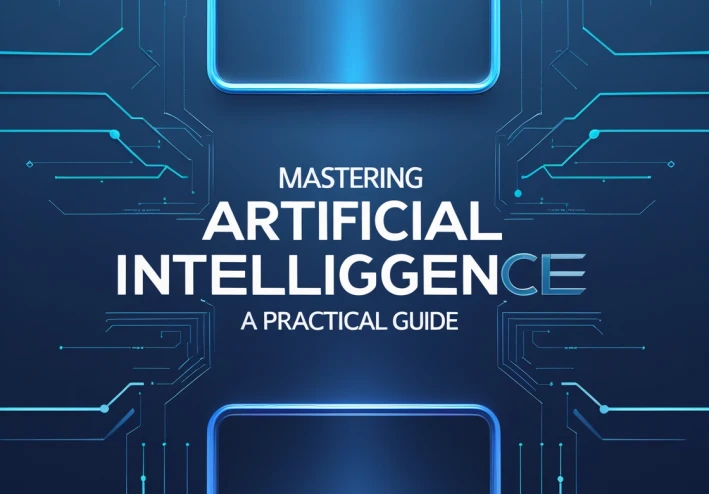
Mastering Artificial Intelligence: A Practical Guide
Guideline 1: Understand the Fundamentals of AI
Content:
To build expertise in AI, it's crucial to first grasp the basics:
- ? What is AI
AI encompasses machine learning, natural language processing, computer vision, and robotics. It’s about creating systems that can perform tasks requiring human intelligence. - Types of AI:
- Narrow AI: Designed for specific tasks (e.g., voice assistants).
- General AI: Has general human-like intelligence (still theoretical).
- Superintelligent AI: Surpasses human intelligence (a future possibility).
- Key Concepts:
- Machine Learning (ML): Training computers to learn from data.
- Deep Learning: A subset of ML using neural networks.
- Natural Language Processing (NLP): Enables machines to understand human language.
- Computer Vision: Teaches machines to interpret visual data.
- Mathematics and Statistics:
Strong foundations in linear algebra, calculus, probability, and statistics are essential. - Programming Basics:
Languages like Python, R, and tools like Jupyter Notebooks are standard in AI development.
Guideline 2: Learn Key AI Technologies
Content:
Once the fundamentals are in place, the next step is to gain hands-on knowledge of the major AI technologies. Each of these plays a significant role in building intelligent systems.
1. Machine Learning (ML):
- Definition: ML is the core of AI, where algorithms learn from data and make predictions or decisions.
- Types of ML:
- Supervised Learning: The model learns from labeled data (e.g., predicting house prices).
- Unsupervised Learning: The model identifies patterns in unlabeled data (e.g., customer segmentation).
- Reinforcement Learning: The model learns by interacting with an environment and receiving feedback (e.g., game-playing agents).
- Popular Algorithms: Linear regression, decision trees, support vector machines, k-nearest neighbors, and neural networks.
2. Deep Learning:
- Definition: A subfield of ML using artificial neural networks with many layers to model complex patterns in data.
- Applications: Image recognition, speech recognition, autonomous vehicles, and more.
- Frameworks to Learn:
- TensorFlow (by Google)
- PyTorch (by Meta)
- Keras (user-friendly API for deep learning)
- Key Concepts: Convolutional Neural Networks (CNNs) for images, Recurrent Neural Networks (RNNs) for sequences, and Transformers for language processing.
3. Natural Language Processing (NLP):
- Definition: NLP allows machines to read, understand, and generate human language.
- Applications: Chatbots, sentiment analysis, machine translation, text summarization.
- Popular Tools and Models:
- spaCy, NLTK, Transformers (like BERT, GPT)
- Large Language Models (LLMs): The basis of tools like ChatGPT
4. Computer Vision:
- Definition: Enables machines to interpret and process visual data.
- Applications: Face recognition, object detection, medical imaging.
- Tools & Libraries:
- OpenCV, YOLO, Detectron2, MediaPipe
5. Robotics and Embedded AI:
- Definition: Integration of AI into physical systems that can sense and act in the real world.
- Examples: Drones, smart appliances, self-driving cars.
6. Cloud AI Services:
- Many platforms provide pre-trained models and scalable infrastructure:
- Google Cloud AI
- Amazon Web Services (AWS) AI/ML
- Microsoft Azure AI
Guideline 3: Master the Tools and Platforms
Content:
To implement AI effectively, you need to be proficient with the tools, libraries, and platforms used in the industry. These technologies enable you to build, train, deploy, and manage AI models efficiently.
1. Programming Languages
- Python:
The most popular language for AI due to its simplicity and vast ecosystem. Most AI libraries are built for Python. - R:
Excellent for statistical analysis and data visualization, often used in academic and research settings. - Other Notables:
- Julia (fast performance for scientific computing)
- JavaScript (for deploying AI in web applications)
- Java/C++ (used in enterprise and high-performance systems)
2. Essential Libraries and Frameworks
- For Machine Learning:
- scikit-learn: Ideal for classical ML algorithms.
- XGBoost, LightGBM: Used in competitive and production ML due to high performance.
- For Deep Learning:
- TensorFlow: Scalable and production-ready.
- PyTorch: More intuitive for research and prototyping.
- Keras: Simplified wrapper over TensorFlow, ideal for beginners.
- For Data Handling and Visualization:
- Pandas, NumPy: For data manipulation.
- Matplotlib, Seaborn, Plotly: For visualizing data and results.
3. Cloud Platforms
AI often requires powerful computing resources. These cloud platforms offer AI-focused services:
- Google Cloud Platform (GCP):
- AutoML, Vertex AI, BigQuery ML
- Pre-trained models for vision, NLP, and translation
- Amazon Web Services (AWS):
- SageMaker for building and deploying models
- Rekognition (image), Comprehend (text), Lex (chatbots)
- Microsoft Azure:
- Azure Machine Learning, Cognitive Services
- Power BI for AI-enhanced analytics
4. Development Environments
- Jupyter Notebook: Interactive coding, ideal for experimentation.
- Google Colab: Free GPU/TPU access for training models.
- VS Code: Feature-rich code editor with extensive support for Python and AI tools.
5. Model Deployment Tools
Getting a model into the real world is critical:
- Flask/FastAPI: Lightweight Python frameworks for building APIs.
- Docker: Containerizes your AI apps for portability and scalability.
- Streamlit/Gradio: Build web apps for models with minimal code.
- ONNX: Open format to represent deep learning models across frameworks.
6. Experiment Tracking and Collaboration
- MLflow, Weights & Biases, Neptune.ai:
Used for tracking experiments, managing datasets, and collaborating with teams.
With these tools and platforms in your toolkit, you can go from idea to production efficiently. They are crucial not only for prototyping but also for scaling AI in real-world applications.
Guideline 4: Work on Real-World Projects
Content:
Applying your knowledge through real-world projects is one of the most effective ways to master AI. Projects not only solidify your understanding but also build a portfolio that showcases your capabilities to potential employers or clients.
1. Why Projects Matter
- Hands-On Experience: Reading about AI is helpful, but building something real gives you problem-solving skills.
- Portfolio Building: Employers value demonstrable skills. A GitHub repository or portfolio website with completed projects can set you apart.
- Learning by Doing: Projects force you to deal with real data, messy inputs, and design decisions.
2. Project Ideas by Difficulty Level
Beginner Projects:
- Spam Classifier: Use NLP to classify emails or comments as spam or not.
- Iris Flower Classifier: A classic dataset to practice basic ML algorithms.
- Stock Price Visualizer: Use real-time APIs to plot and analyze market trends.
Intermediate Projects:
- Movie Recommendation System: Build a system based on user preferences and collaborative filtering.
- Face Recognition App: Use OpenCV or deep learning to recognize faces in images or live video.
- Sentiment Analysis Tool: Scrape product reviews and analyze sentiment with NLP.
Advanced Projects:
- Chatbot with NLP: Build a conversational assistant using deep learning models.
- Self-Driving Car Simulation: Use reinforcement learning and computer vision to train agents in simulators like CARLA.
- AI for Medical Imaging: Train models to detect anomalies in X-rays or MRIs using CNNs.
3. Best Practices for Projects
- Start with a Clear Goal: Define what the AI system should do and what success looks like.
- Use Public Datasets: Sites like Kaggle, UCI Machine Learning Repository, and Google Dataset Search offer great datasets to start with.
- Version Control: Use Git and GitHub to track your code and collaborate.
- Documentation: Clearly explain your approach, dataset, model choices, and results.
- Experimentation: Try different algorithms, tune hyperparameters, and compare performance.
4. Where to Host and Share Projects
- GitHub: Industry standard for sharing code.
- Hugging Face Spaces: Host models and demos using Streamlit or Gradio.
- Kaggle: Participate in competitions or publish your notebooks.
- Personal Portfolio Website: Show off your best work with descriptions, screenshots, and links.
5. Collaborate and Contribute
- Open Source Projects: Contribute to existing AI libraries or research projects.
- Hackathons: Join online or in-person AI hackathons to work on real problems with others.
- Communities: Platforms like Reddit (r/MachineLearning), AI Discord groups, and LinkedIn communities are great for feedback and learning.
Real-world projects bridge the gap between theory and application. They’re where learning turns into expertise, and curiosity becomes innovation.
Guideline 5: Stay Ethical and Responsible
Content:
As AI grows more powerful and integrated into society, ethical considerations become crucial. Developers and organizations must ensure that AI systems are fair, transparent, accountable, and aligned with human values.
1. Why AI Ethics Matters
- Impact on Society: AI systems influence decisions in hiring, policing, healthcare, and more. A biased or opaque system can harm individuals or groups.
- Public Trust: People are more likely to adopt and support AI when it's used responsibly.
- Regulatory Compliance: Governments are enacting laws to ensure ethical AI (e.g., GDPR in Europe, AI Act, U.S. AI Bill of Rights).
2. Core Principles of Ethical AI
Fairness:
- Avoid discrimination based on race, gender, age, or other attributes.
- Use balanced datasets and test models for bias.
- Employ fairness-aware algorithms (e.g., reweighting, adversarial debiasing).
Transparency:
- Make AI decisions understandable to users and stakeholders.
- Use interpretable models when possible, or apply tools like SHAP or LIME for explanation.
Accountability:
- Identify who is responsible for AI outcomes.
- Keep logs of decisions, data sources, and model changes.
Privacy:
- Protect user data through encryption, anonymization, and strict access controls.
- Use privacy-preserving techniques like federated learning or differential privacy.
Safety:
- Ensure models perform reliably, especially in critical areas like healthcare or transportation.
- Test extensively for edge cases and unexpected behaviors.
Sustainability:
- Be mindful of the energy and resource consumption of training large models.
- Consider model efficiency and use cloud providers with green infrastructure.
3. Ethical Dilemmas in AI
- Deepfakes and Misinformation: AI-generated media can deceive the public.
- Surveillance vs. Security: Facial recognition can help law enforcement—but at what cost to civil liberties?
- Job Automation: Balancing innovation with economic displacement and workforce retraining.
4. Frameworks and Guidelines
- OECD AI Principles
- IEEE Global Initiative on Ethics of Autonomous and Intelligent Systems
- UNESCO Recommendations on the Ethics of AI
- AI Ethics Guidelines by major tech companies (Google, Microsoft, IBM)
5. Best Practices for Developers
- Ethics by Design: Consider ethical impacts from the start—not as an afterthought.
- Diverse Teams: Diverse perspectives help catch bias early.
- Audit Regularly: Review datasets, code, and results for ethical risks.
- User Feedback: Involve end users in design and post-deployment monitoring.
AI should benefit everyone—not just a few. As a creator, you play a key role in shaping how AI impacts the world. Responsible AI isn’t just good practice—it’s essential.
Guideline 6: Keep Up with Industry Trends
Content:
AI is a fast-moving field. New models, tools, research papers, and use cases emerge almost daily. To stay relevant and competitive, you must continually update your knowledge and adapt to changes.
1. Follow Cutting-Edge Research
- Top Conferences:
- NeurIPS (Neural Information Processing Systems)
- ICML (International Conference on Machine Learning)
- CVPR (Computer Vision and Pattern Recognition)
- ACL (Association for Computational Linguistics)
- AAAI (Association for the Advancement of Artificial Intelligence)
- Resources for Papers:
- arXiv.org for preprints
- Papers with Code (see papers, code, and benchmarks together)
- Semantic Scholar for AI and machine learning literature
- Tips:
- Read abstracts and conclusions if short on time.
- Focus on papers in your area of interest.
2. Subscribe to AI News and Blogs
- Newsletters:
- The Batch by Andrew Ng
- Import AI by Jack Clark
- Towards Data Science on Medium
- AI Weekly
- Blogs from Industry Leaders:
- OpenAI Blog (ChatGPT, GPT research)
- DeepMind Blog
- Google AI Blog
- Meta AI Research
3. Learn from Online Communities
- Reddit:
- r/MachineLearning
- r/Artificial
- r/LanguageTechnology
- Twitter/X and LinkedIn:
Follow researchers, engineers, and organizations that share insights and breakthroughs. - Discord and Slack Channels:
Join AI-focused servers for live discussions and networking. - Stack Overflow and GitHub:
Ask questions, contribute to projects, and follow trending repositories.
4. Take Ongoing Courses and Certifications
- Popular Platforms:
- Coursera (DeepLearning.AI, Stanford’s ML courses)
- edX, Udacity, MIT OpenCourseWare
- fast.ai for hands-on deep learning
- Certificates to Consider:
- Google Professional ML Engineer
- Microsoft Azure AI Fundamentals
- IBM AI Engineering
5. Track Real-World AI Applications
- Follow how AI is used in:
- Healthcare (diagnostics, drug discovery)
- Finance (fraud detection, algorithmic trading)
- Retail (recommendation engines, customer service)
- Education (adaptive learning platforms)
- Analyze what’s successful and why. Look for gaps where AI can add value.
6. Experiment with New Tools and Models
- Try the latest open-source tools and APIs:
- Hugging Face Transformers, LangChain, OpenAI API
- Run models locally with tools like LLM Studio, AutoGPT, Ollama
- Use sandbox environments for fast prototyping
- Keep a project or notebook just for trying out new tech—this builds confidence and agility.
Staying current ensures your AI skills don’t just keep pace—they stay ahead. Continuous learning is your competitive advantage in a dynamic and evolving field.
Conclusion and Next Steps
Artificial Intelligence is not just a technology—it’s a transformative force that is reshaping the way we live, work, and think. By following the guidelines in this e-book, you’ve taken important steps toward building a solid foundation in AI and preparing yourself for an exciting and impactful journey in this field.
Key Takeaways
- Start with the fundamentals. A strong grasp of AI concepts, math, and programming is essential.
- Learn the technologies. From machine learning to NLP and computer vision, mastering key domains opens the door to countless possibilities.
- Use the right tools. Efficient development and deployment require familiarity with modern platforms, frameworks, and libraries.
- Build real-world projects. Practice is the best teacher. Projects give you experience, confidence, and a showcase for your skills.
- Be ethical and responsible. With great power comes great responsibility. AI developers must uphold fairness, transparency, and accountability.
- Stay updated. The field evolves rapidly—make learning a lifelong habit.
Next Steps
- Choose a Specialization:
Explore areas like NLP, computer vision, reinforcement learning, or AI ethics and decide where you want to go deeper. - Join the Community:
Connect with other learners and professionals. Collaboration and shared learning are powerful accelerators. - Start Freelancing or Contributing:
Apply your skills to freelance work, open-source projects, or internships to gain real-world experience. - Keep a Learning Log:
Document what you learn, build, and read. It keeps you motivated and creates a resource for future reference. - Plan for Advanced Learning:
Consider formal degrees, certifications, or research opportunities if you’re looking to specialize or contribute academically.
Final Words
The AI field is vast, vibrant, and full of opportunity. Whether you're building a smarter app, automating processes, solving global challenges, or just exploring curiosity, your journey in AI has the potential to create real value—for yourself and the world.
Stay curious. Stay humble. Keep building.
Welcome to the world of AI.
































